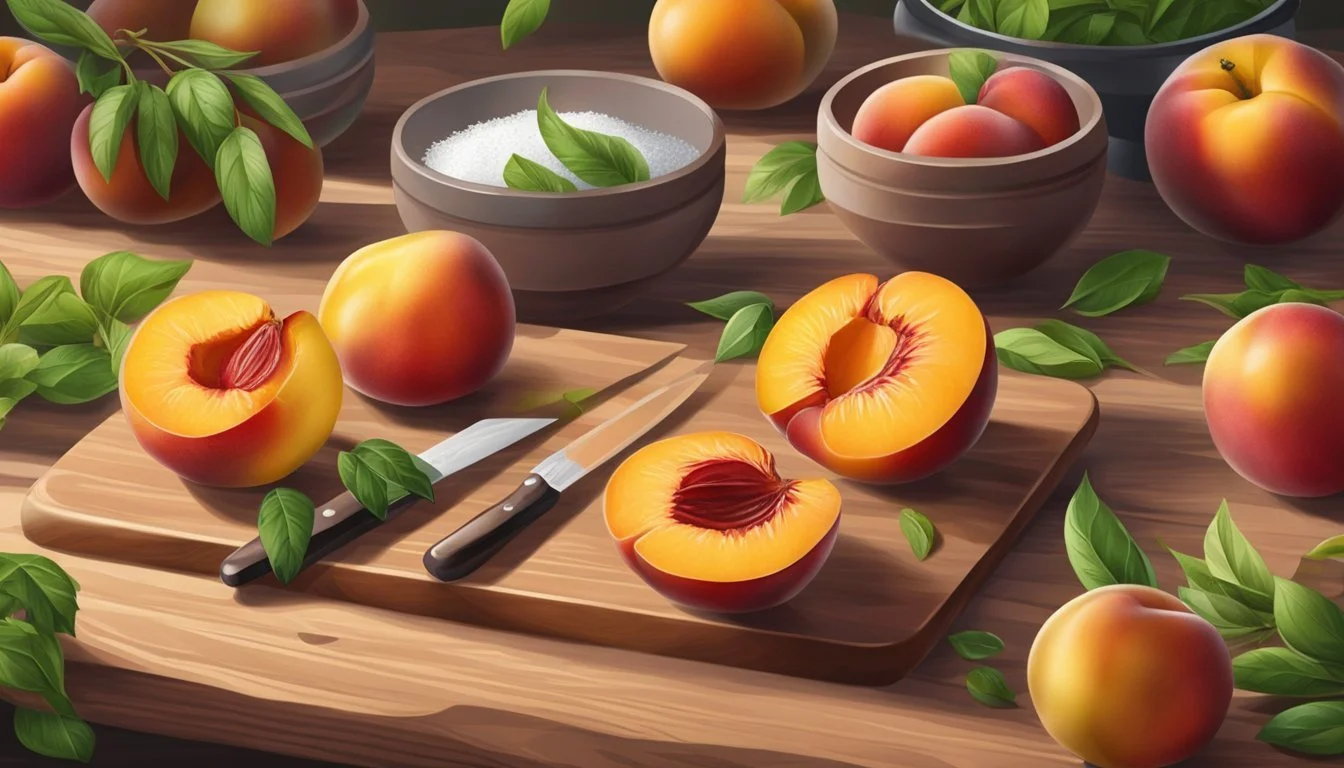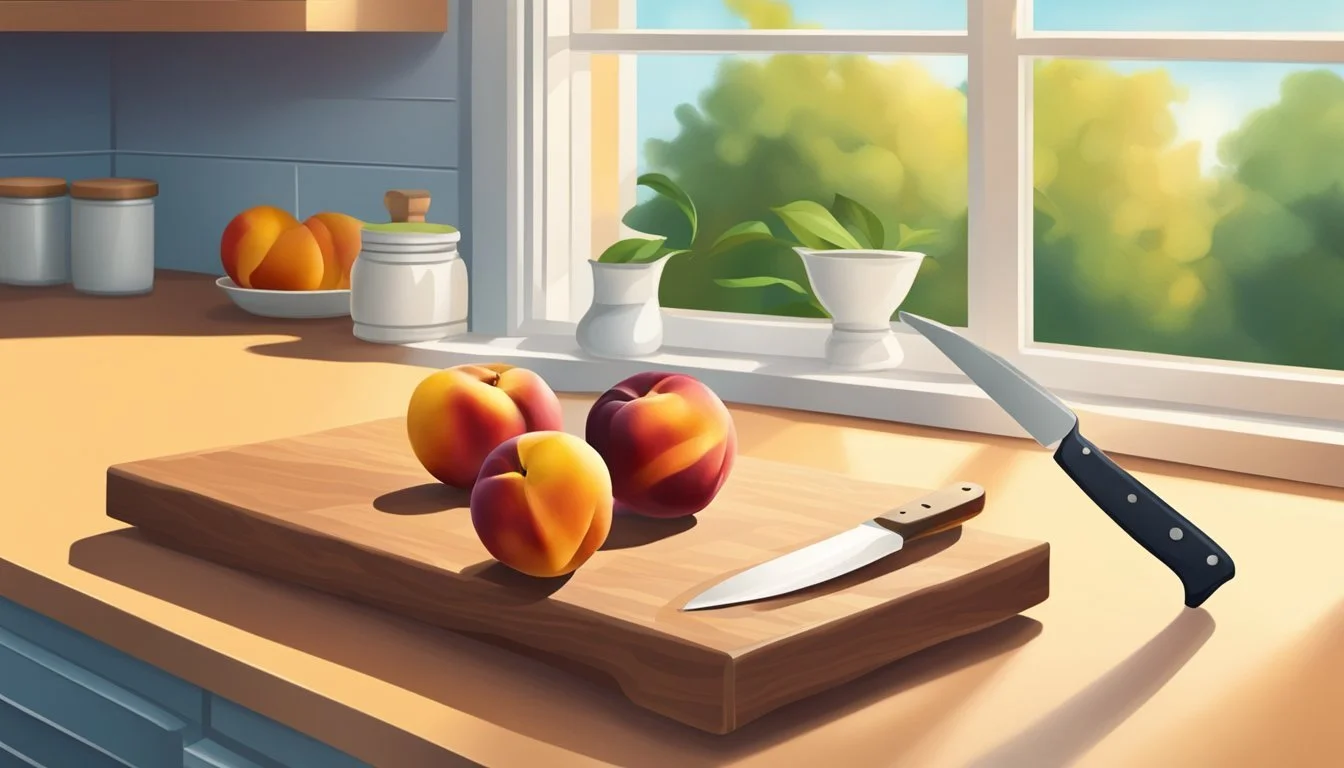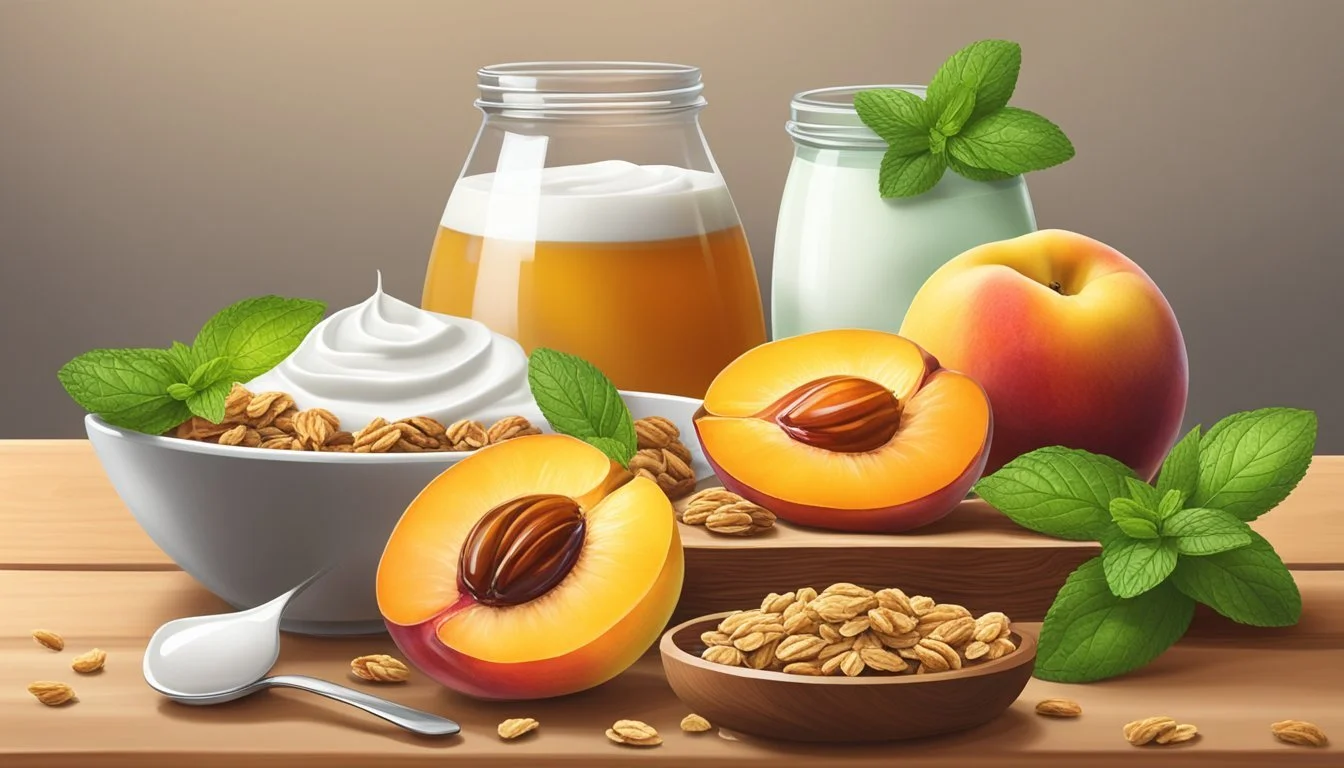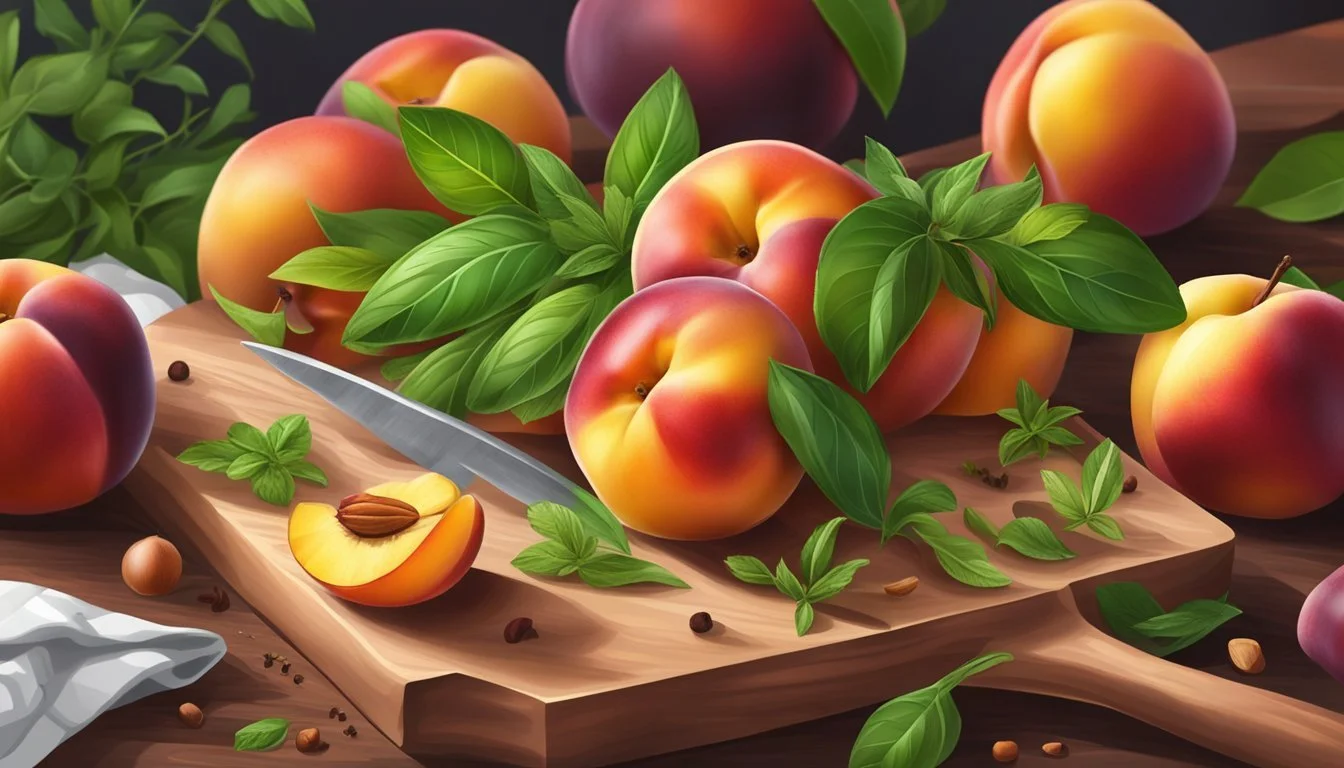How to Cook with Nectarines for Summer Flavors
Fresh and Vibrant Recipes Revealed
Nectarines, with their smooth skin and sweet, succulent flesh, are a staple summer fruit that can elevate the flavors of any dish. This delectable stone fruit, while closely related to the peach, holds its unique taste and firm texture that makes it incredibly versatile, whether it's used in sweet or savory recipes. Throughout the sun-filled months, cooking with nectarines can introduce a juicy, fresh element to meals, as they complement both the light and hearty fares often enjoyed during the season.
Incorporating nectarines into cooking can range from simple preparations to more intricate dishes. Rinsing the fruit under running water to cleanse any residue is always a necessary first step. To optimally infuse the sweet flavor of nectarines into a variety of dishes, they can be sliced uniformly for even cooking or can be grilled to add a smoky nuance. Whether gently folded into a vibrant summer salad accented with tangy vinaigrette and creamy cheese or baked into a warm, rustic dessert, the nectarine's versatility shines.
As the heat of summer sets in, the kitchen becomes a place to experiment with the season's bounty. Nectarines present countless opportunities for culinary creativity, from refreshing pickled nectarine salads (What wine goes well with salads?) paired with soft burrata to a succulent chicken dish topped with a nectarine fruit salsa. With such a broad spectrum of possible recipes, cooking with nectarines is about embracing the season's flavors, transforming simple ingredients into memorable summer meals.
Selecting the Perfect Nectarines
When choosing nectarines for cooking, it's essential to consider their ripeness and whether they are freestone or clingstone, as this impacts both texture and ease of preparation.
Understanding Ripeness and Texture
A ripe nectarine will have a slight give when gently pressed; it should feel firm but not hard. The skin of a ripe nectarine is often vibrant in color with a slight velvety texture and should be free of wrinkles and blemishes. Overripe nectarines may be overly soft and can be better suited for purees or sauces, whereas underripe ones can be too firm and acidic, lacking the desirable sweet flavor.
Differences Between Freestone and Clingstone
Freestone Nectarines
Pit separates easily from the flesh
Ideal for slicing and eating fresh
Preferred for most cooking applications
Clingstone Nectarines
Pit adheres to the flesh
Can be more challenging to prepare
Often used for making jams or recipes where the shape of the fruit is less critical
Both types can be enjoyed in various culinary applications, but freestones are typically more user-friendly for slicing and presentation.
Storing Nectarines for Freshness
Proper storing of nectarines is critical to maintain their freshness and flavor. Understanding the best practices for storing nectarines can ensure they remain ripe and ready for cooking.
Refrigerator vs. Room Temperature
Refrigerator: Ripe nectarines should be stored in the refrigerator, specifically in the crisper drawer. This area provides a cool, consistent temperature and a slightly higher humidity level that is ideal for preserving the fruit's freshness.
Ideal temperature in the refrigerator for nectarines: 32°F to 40°F (0°C to 4°C)
Room Temperature:
Unripe nectarines benefit from being left at room temperature, away from direct sunlight.
They ripen best at temperatures between 68°F to 77°F (20°C to 25°C).
Once ripened, they should be moved to the refrigerator to prolong freshness.
Avoiding Common Storing Mistakes
Rinse and Dry Thoroughly: Nectarines must be clean before storage. They should be rinsed well and dried completely to prevent mold growth.
Do Not Overcrowd: Nectarines should not be overcrowded in storage. Allow space between the fruits (What wine goes well with fruits?) to ensure proper air circulation and to prevent bruising.
Consistent Storage: To avoid texture and taste degradation, nectarines should not be subjected to temperature fluctuations. Once refrigerated, they should stay refrigerated until ready to use.
Preparation Basics
When preparing nectarines for cooking, one must focus on proper cleaning and accurate cutting techniques. This ensures the flavors are maximized and the fruit is ready for a variety of recipes.
Washing and Pitting
Washing: Before any slicing takes place, nectarines need to be thoroughly washed to remove any surface dirt or residues. They should be gently rinsed under running water and then patted dry with a clean towel.
Pitting:
Place the nectarine on a stable cutting board.
Identify the natural seam running along the fruit.
Cut into the nectarine along the seam until the knife reaches the pit.
Twist the halves in opposite directions to separate them.
Slice the half with the pit again, if necessary, and remove the pit with care.
Slicing and Dicing for Recipes
Slicing:
For even cooking or presentation, slices should be uniform.
Take each pitted half and place it cut side down on the cutting board for stability.
Cut into slices or wedges, depending on the recipe's requirement.
Dicing:
To dice, start with slices of nectarine.
Cut slices into strips and then turn and cut across to create a dice.
Ensure pieces are consistent in size for even cooking and texture within the dish.
Properly prepared nectarines can enhance the flavor profile of salads, baked goods, and various other dishes with their sweet and tangy notes.
Cooking Techniques
Exploring various cooking techniques allows for the full appreciation of nectarines' versatility in summer dishes.
How to Grill Nectarines
Grilling nectarines enhances their natural sweetness and adds a smoky flavor. First, one should slice the nectarines in half and remove the pit. Brush the cut surfaces lightly with oil to prevent sticking. Preheat the grill to medium heat, and place the fruit cut-side down on the grill grate. Grill for 4-5 minutes or until grill marks appear and the fruit softens slightly.
Baking with Nectarines
Nectarines can be baked whole, sliced, or chopped, depending on the recipe. To bake, preheat the oven to 350 degrees Fahrenheit. Prepare the nectarines by washing, slicing, and pitting them. Arrange them in a baking dish, optionally sprinkling with sugar or drizzling with honey for added sweetness. Add dots of butter over the top before placing them in the oven. Bake until tender, which usually takes about 20-25 minutes.
Making Nectarine Jams and Sauces
Jam making is a traditional method to preserve the summer flavor of nectarines. Combine chopped nectarines, sugar, and a squeeze of lemon juice in a saucepan. Cook over medium heat, stirring regularly. To thicken the mixture, cook until it reaches the desired consistency. Pour the jam into sterilized jars for longer storage. Sauces can be prepared similarly but may be blended for a smooth texture and seasoned to taste.
Roasting Nectarines for Savory Dishes
Roasted nectarines add a sweet dimension to savory dishes. Preheat the oven to 400 degrees Fahrenheit. Cut the nectarines into wedges, toss with oil, and season as desired—spread them on a baking sheet in a single layer. Roast in the oven until they begin to caramelize and soften, approximately 15-20 minutes. They can be served alongside meats or incorporated into salads.
Nectarine-Inspired Recipes
Nectarine's natural sweetness and vibrant flavors make it an excellent ingredient for a variety of dishes, complementing both sweet and savory preparations. Below are inspirational recipes that showcase the versatility of nectarines in culinary creations.
Sweet Treats and Desserts
Nectarine Cobbler: For a classic summer dessert, bake nectarines with a mixture of sugar, vanilla extract, and a touch of cinnamon until bubbly. Top with a buttery biscuit crust and serve warm with a scoop of vanilla ice cream.
Nectarine Pie: Slice nectarines and toss them with honey, a hint of vanilla, and a sprinkle of sugar for the filling. Encase in a flaky double pie crust and bake until golden brown.
Baked Nectarines: Halve nectarines and remove the seed. Drizzle with honey and a pinch of cinnamon, then bake until tender. Top with whipped cream or a dollop of vanilla ice cream.
Savory Nectarine Dishes
Grilled Nectarine Salad: Grill nectarine slices until charred, then combine with mixed greens, berries, and crumbled cheese. A balsamic reduction or citrus dressing complements the sweet and tangy flavors.
Nectarine Salsa: Dice nectarines and mix with red onion, cilantro, jalapeño, and lime juice for a refreshing twist on traditional salsa. Serve with grilled fish or chicken.
Nectarine Pizza: Top a pizza base with thinly sliced nectarines, goat cheese, and a drizzle of honey before baking. Finish with fresh basil for a gourmet summer meal.
Refreshing Nectarine Beverages
Nectarine Sorbet: Puree nectarines with sugar and lemon juice, then churn in an ice cream maker for a cool, refreshing sorbet that captures the essence of summer in every spoonful.
Nectarine Iced Tea: Infuse chilled tea with nectarine slices and a hint of vanilla or cinnamon. Sweeten with honey and garnish with fresh mint leaves for a hydrating summertime drink.
Pairing Nectarines with Other Ingredients
Nectarines, with their sweet and slightly tart flavor, enhance a variety of dishes when paired with complementary ingredients ranging from cheeses to salads and other fruits.
Cheese and Nectarine Combinations
When it comes to cheese pairings, nectarines are highly versatile. Goat cheese and feta are excellent choices for a lighter fare, while nectarines' natural sweetness pairs beautifully with the creaminess of these cheeses. For a sophisticated twist, a drizzle of balsamic vinegar on top ties the flavors together. Incorporating stones fruits like nectarines alongside cheese in a platter offers a well-balanced and appealing appetizer option.
Creating Salads with Nectarines
Salads gain a refreshing sweetness with the addition of ripe nectarines. Greens such as arugula provide a peppery contrast to the fruit's sweetness, while a vinaigrette enhances the overall flavor profile. Adding pistachios not only contributes a satisfying crunch but also ups the nutritional value. Salads incorporating nectarines are perfect for summer events where fresh, light ingredients are favored.
Example Salad Combination:
Greens: Arugula or mixed greens
Nectarines: Sliced ripe nectarines
Cheese: Crumbled goat cheese or feta
Extras: Toasted pistachios, optional berries
Dressing: Balsamic vinaigrette
Fruit Medleys: Mixing Nectarines and Other Fruits
A vibrant fruit salad is one of the most refreshing ways to enjoy nectarines. They blend seamlessly with various berries — raspberries and blueberries offer a mix of tart and sweet flavors that complement the nectarine's profile. The resulting medley is not only colorful but also a treasure trove of vitamins and antioxidants.
Ideal Fruit Salad Ingredients:
Stone Fruit: Nectarines, sliced or diced
Berries: Blueberries, raspberries, or strawberries
Citrus: A splash of lemon or lime juice for zest and preservation
Herbs: A hint of fresh mint or basil to enhance the freshness
By carefully selecting ingredients that balance or accentuate the flavors of nectarines, one can create delectable pairings that are perfect for summer meals.
Nutritional Benefits of Nectarines
Nectarines are a nutritious stone fruit with a rich profile of vitamins and minerals, making them a valuable addition to a healthy diet. They boast a notable fiber content benefiting digestive health.
Vitamins and Minerals
Nectarines provide an array of essential vitamins and minerals. They are particularly noted for their vitamin C content, with a typical medium-sized nectarine offering about 8.5% of the recommended daily value. This vitamin is crucial for immune system function, collagen production, and cellular health.
Other key nutrients found in nectarines include:
Vitamin A: Important for vision and immune function.
Potassium: Supports heart health by helping to regulate blood pressure.
A table summarizing the vitamin and mineral content per medium-sized fresh nectarine:
Nutrient Amount % Daily Value* Vitamin C 7.67 mg 8.5% Vitamin A 27.1 mcg Varies Potassium Varies Varies
* Percent Daily Values are based on a 2000 calorie diet. Actual values may vary.
Fiber Content and Digestive Health
Nectarines contribute to digestive health through their fiber content. One medium-sized nectarine contains approximately 2.4 grams of fiber, accounting for a significant portion of the daily recommended intake. Dietary fiber aids in maintaining regular bowel movements and can help prevent constipation. It may also play a role in weight management by increasing the feeling of fullness.
Seasonal and Event-Themed Cooking
Nectarines are a versatile stone fruit that can be incorporated into a myriad of dishes and are perfect for celebrating the flavors of summer through various events and holidays.
Summer Picnics with Nectarines
Picnics epitomize summer leisure, and nectarines contribute both a vibrant look and taste to any outdoor spread. They shine brightly in fresh fruit salads or can be baked into handheld pies that are easy to pack and share. An ideal picnic fruit salad might include bite-sized nectarine pieces with a variety of other summer fruits, dressed lightly with honey and a squeeze of fresh lime juice.
Easter Brunch Ideas
For an Easter brunch (What wine goes well with brunch?), nectarines can add a sweet and tangy touch to the table. One could thinly slice nectarines and layer them into a springtime tart or incorporate them into a savory bread pudding. Nectarine compote makes for a delightful topping on pancakes, waffles, or breads to bring that sweet flavor that pairs well with other brunch staples.
Creative Twists for Holiday Baking
When the holidays roll around, nectarines can surprisingly enhance traditional baking. Incorporating nectarine slices into breads or muffins adds a moist, sweet element. For a holiday treat, nectarines can be poached in a light syrup with spices such as cinnamon and cloves and then arranged atop cakes or used to fill pastries, offering a twist on the typical holiday desserts.
Advanced Techniques and Presentation
When cooking with nectarines, mastery of advanced techniques can amplify the natural flavors of this stone fruit, while thoughtful presentation elevates the dining experience.
Elevating Your Dessert Presentation
Sheer visual appeal is essential when presenting nectarine desserts. Incorporating grill marks on nectarine slices can add both a smoky flavor and striking contrast in color, enhancing the texture and bringing a tender juiciness to the dish. One can achieve this by lightly brushing nectarine halves with oil and placing them on a hot grill for a few minutes, until charred lines appear. Serve these grilled slices atop a panna cotta or mascarpone cream in a clear glass to showcase the layers of color and texture.
Technique: Grilling nectarines
Tool: Grill
Presentation: Layer in a glass
Integrating Nectarines into Gourmet Meals
Nectarines bring a juicy sweetness to gourmet plates that can be expertly balanced with savory counterparts. When considering the plate's architecture, chefs should aim for a harmonious composition that marries textures and colors. For example, a sliced nectarine fan next to a perfectly cooked duck breast creates an interplay between the crispy, rich meat and the soft, succulence of the ripe fruit. Alternatively, incorporating nectarines into a savory chutney or salsa can provide a complex, developed flavor profile, ideal for dressing up grilled fish or pork.
Technique: Complementing savory dishes
Texture: Tender and crispy juxtaposition
Presentation: Sliced fan or chutney on a gourmet plate
Tips for Cooking with Stone Fruits
When cooking with stone fruits such as nectarines, peaches, and plums, it's important to leverage their seasonal freshness and consider proper pairing and seasoning to enhance their natural flavors.
Pairing Wines with Stone Fruit Dishes
Selecting the right wine can elevate the taste of stone fruit dishes. A general principle is to match the wine's sweetness level with that of the dish. For instance:
Roasted peaches: Pair with a sweet and aromatic Moscato, as its light body complements the caramelized notes of the fruit without overwhelming them.
Plum tarts: Choose a semi-sweet Riesling, which offers a balance of acidity that works well with the tartness of the plums.
Mastering the Art of Stone Fruit Seasonings
The seasoning of stone fruits can amplify their inherent flavors:
Salt: A small pinch of salt sprinkled on stone fruits can intensify their sweetness and overall flavor profile. This is especially effective with nectarines, where a balance between sweet and savory notes can be achieved.
Temperature: Roasting stone fruits at a high temperature, around 375-400 degrees F, helps caramelize their natural sugars, making them excellent for desserts or savory dishes.
When serving, ensure that the stone fruits are the star by keeping additional flavors complementary and not overpowering. Whether one is using nectarines, peaches, or plums, it's essential to honor the distinct characteristics of each fruit and the versatility they offer in both sweet and savory culinary creations.
Sustainable Practices and Considerations
When preparing nectarines for your summer dishes, sustainable practices can greatly enhance both the flavor and the ecological footprint of your cooking. It’s essential to consider the source of the fruit and the methods used in its preparation.
Choosing Organic and Locally-Sourced Nectarines
Organic nectarines are cultivated without the use of synthetic pesticides, fertilizers, or genetically modified organisms, which can be more beneficial for the environment. Choosing locally-sourced nectarines not only supports local farmers and reduces transportation emissions, but also typically results in fresher fruit due to the shorter time from farm to table.
Benefits of local organic nectarines include:
Reduced chemical runoffs and healthier soils
Promotion of biodiversity
Decreased carbon footprint due to minimal transport distances
Reducing Waste in Nectarine Cooking
To minimize waste while cooking with nectarines, one can use as much of the nectarine as possible. The peels and flesh are often used in various recipes, and even the pits can serve a purpose in creating infusions or as compost.
Ways to reduce waste with nectarines:
Composting: Organic matter such as nectarine scraps enriches soil.
Canning: Preserves the fruit, extending its shelf-life and reducing food waste.
Utilizing the whole fruit: Snacks, sauces, and dressings can be made from parts often discarded.
Implementing these sustainable practices can contribute to a better environment and can ultimately enhance one’s cooking with the delightful summer flavor of nectarines.








